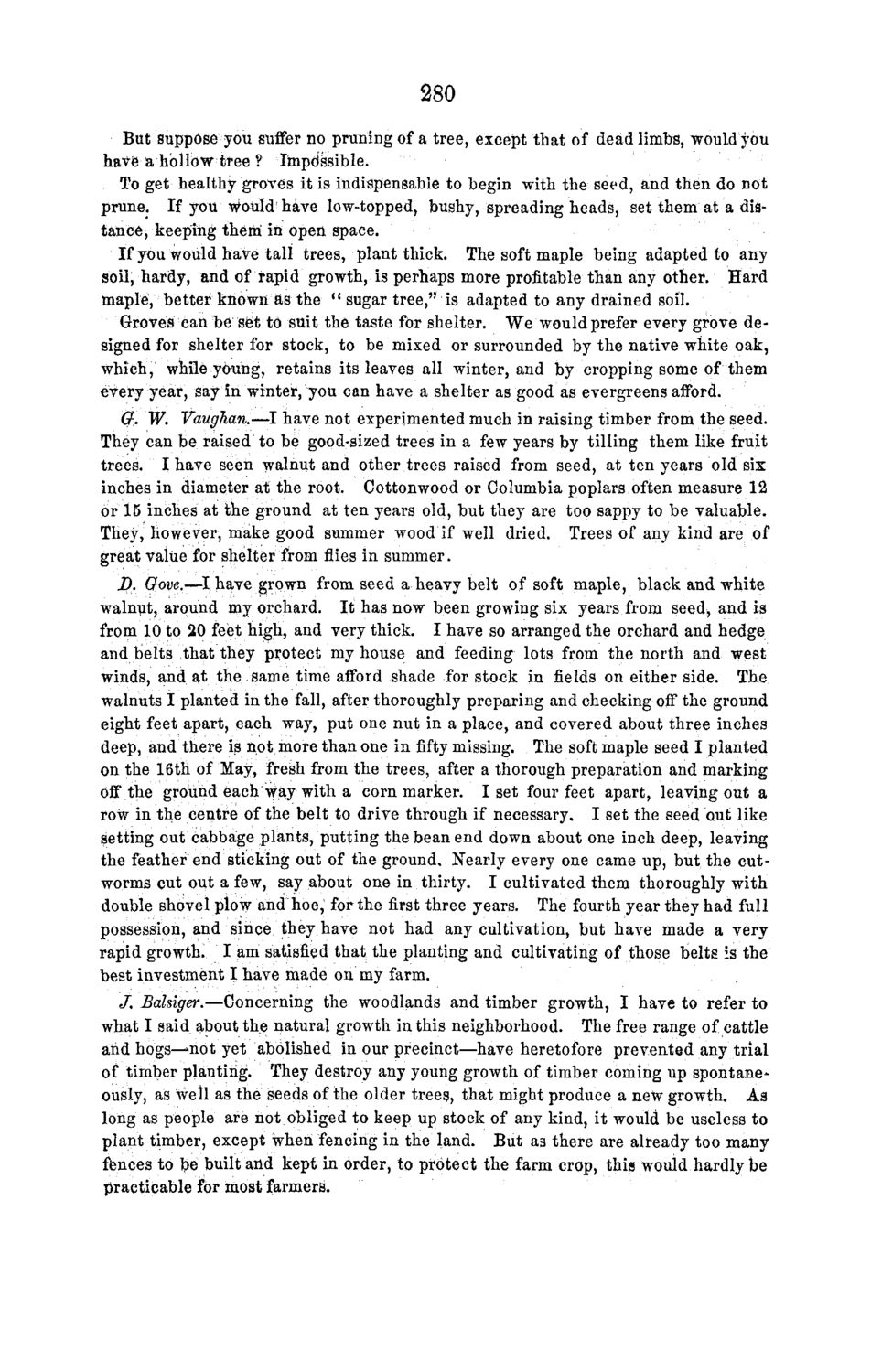| |
| |
Caption: Board of Trustees Minutes - 1868
This is a reduced-resolution page image for fast online browsing.

EXTRACTED TEXT FROM PAGE:
280 But suppose you suffer no pruning of a tree, except that of dead limbs, would you have a hollow tree ? Impossible. To get healthy groves it is indispensable to begin with the seed, and then do not prune. If you Would have low-topped, bushy, spreading heads, set them at a distance, keeping them in open space. If you would have tall trees, plant thick. The soft maple being adapted to any soil, hardy, and of rapid growth, is perhaps more profitable than any other. Hard maple, better known &s the "sugar tree," is adapted to any drained soil. Groves can be set to suit the taste for shelter. We would prefer every grove designed for shelter for stock, to be mixed or surrounded by the native white oak, which, while young, retains its leaves all winter, and by cropping some of them every year, say in winter, you can have a shelter as good as evergreens afford. G. W. Vaughan,—I have not experimented much in raising timber from the seed. They can be raised to be good-sized trees in a few years by tilling them like fruit trees. I have seen walnut and other trees raised from seed, at ten years old six inches in diameter at the root. Cottonwood or Columbia poplars often measure 12 or 15 inches at the ground at ten years old, but they are too sappy to be valuable. They, however, make good summer wood if well dried. Trees of any kind are of great value for shelter from flies in summer. D. Gove.—I have grown from seed a heavy belt of soft maple, black and white walnut, around my orchard. It has now been growing six years from seed> and is from 10 to £0 feet high, and very thick. I have so arranged the orchard and hedge and belts that they protect my house and feeding lots from the north and west winds, and at the same time afford shade for stock in fields on either side. The walnuts I planted in the fall, after thoroughly preparing and checking off the ground eight feet apart, each way, put one nut in a place, and covered about three inches deep, and there is not more than one in fifty missing. The soft maple seed I planted on the 16th of May, fresh from the trees, after a thorough preparation and marking off the ground each way with a corn marker. I set four feet apart, leaving out a row in the centre of the belt to drive through if necessary, I set the seed out like setting out cabbage plants, putting the bean end down about one inch deep, leaving the feather end sticking out of the ground, Nearly every one came up, but the cutworms cut out a few, say about one in thirty. I cultivated them thoroughly with double shovel plow and hoe,' for the first three years. The fourth year they had full possession, and since they have not had any cultivation, but have made a very rapid growth. I am satisfied that the planting and cultivating of those belts is the best investment I have made on my farm. J. Balsiger.—Concerning the woodlands and timber growth, I have to refer to what I said about the natural growth in this neighborhood. The free range of cattle and hogs-—not yet abolished in our precinct—have heretofore prevented any trial of timber planting. They destroy any young growth of timber coming up spontanea ously, as well as the seeds of the older trees, that might produce a new growth. As long as people are not.obliged to keep up stock of any kind, it would be useless to plant timber, except when fencing in the land. But a3 there are already too many fences to Tbe built and kept in order, to protect the farm crop, this would hardly be practicable for most farmers.
| |